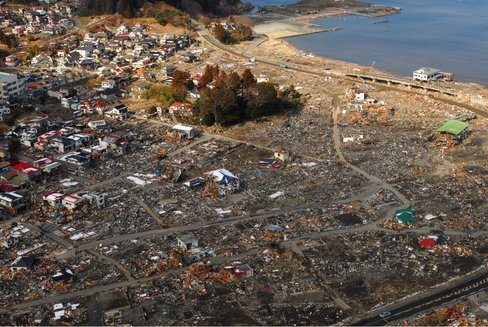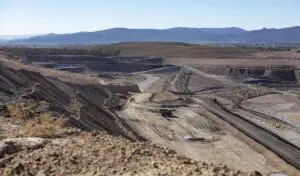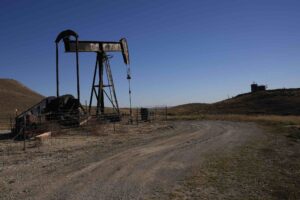
With Puerto Rico’s dirty, costly electric grid wiped out by Hurricane Maria, now is the time for a clean power rebuild.
Microgrids built around cheap renewable power and battery storage are now the fastest and cheapest way to restore power — while at the same time building resilience into the grid against the next disaster.
That’s been proven by Florida after Hurricane Irma, Japan after the tsunami that caused the Fukushima meltdown, and India after recent monsoons.

Unfortunately, the anti-renewable Trump administration appears unlikely to pursue this winning strategy. Indeed, Energy Secretary Rick Perry said Tuesday that small nuclear power plants being researched at national labs are the kind of “innovation” he’d like to “expedite” for Puerto Rico’s rebuild.
“Wouldn’t it make abundant good sense if we had small modular reactors that literally you could put in the back of C-17 [military cargo] aircraft, transport it to an area like Puerto Rico, and push it out the back end, crank it up, and plug it in?” he said at an event in Washington, D.C. for National Clean Energy Week. “Hopefully, we can expedite that.”
It would be quite an effort of expedition. Such small nuclear power plants are not expected to be commercialized until the mid-2020s, and even if they are, they are projected to be wildly expensive — just like current reactors — and not that small (650 tons). Nobody’s going to be “literally” putting one in a C-17 and pushing it out the back end on a small island ready to go.
The U.S. territory doesn’t have time for such political pipe dreams.
Right now, Puerto Rico’s desperate lack of power — for hospitals, water and sewage facilities, and air-conditioning in the sweltering heat — is at the center of the ongoing humanitarian crisis for the 3.4 million U.S. citizens in Puerto Rico.
Hurricane Maria destroyed 55 percent of the transmission towers that support high-voltage power lines and wrecked 90 percent of the distribution network, according to utility experts who have assessed the damage, Reuters reported.
Reuters put together this remarkable graphic on “power restoration after major U.S. hurricanes.”
But this tragedy does open an opportunity. The old grid was an antiquated, expensive, polluting disaster. Mired in debt, the local utility declared bankruptcy in July. (For a useful history, see the Huffington Post’s “Puerto Rico’s Colonial Legacy Doomed It To Dirty Electricity — And Now Darkness.”)
Only 2 percent of the sunny and windy Caribbean island’s electricity comes from renewables, while all the rest comes from fossil fuels. In 2016, an astounding 47 percent of electricity came from petroleum, especially from dirty, inefficient diesel generators. By comparison, the U.S. as a whole generates under 1 percent of its power from petroleum and 15 percent from renewables.
Bringing fuel to an island is expensive. The commercial price of electricity on Puerto Rico is an astounding 21.4 cents per kilowatt-hour, compared to 11 ¢/kwh for the mainland. The industrial price of electricity on the island is an unheard of 18 ¢/kwh, compared to 7 ¢/kwh for the mainland.
No wonder the utility is bankrupt, and the island is economically uncompetitive.
In terms of speed of recovery, nothing beats solar with storage. As Inside Climate News reported, Florida homes with solar panels and batteries that lost power from Irma in the early hours of Monday, September 11 were able to restore power in a few hours when the sun came up. Long before others, they could use lights, refrigerators, and wifi.
Coral Springs Florida used solar plus batteries to quickly restore 13 major traffic lights. Although it’s worth noting that solar homes without storage are out of luck in Florida. The utility, FPL, does not allow grid-connected systems without batteries to be used during an outage. And the state code requires you to be connected to the grid even if you could be grid free.
Temporary solar traffic signals have been placed at intersections to ensure your safety. If no traffic signal, use as a four-way stop. pic.twitter.com/FdaG9IQwlt
— Coral Springs Police (@CoralSpringsPD) September 11, 2017
Case studies from Japan, India, and Hawaii also make clear the only technologies that can simultaneously deliver the fastest, cheapest, cleanest, and most disaster-resilient rebuild possible are micro-grids built around renewables and storage.
When northeast India was ravaged by an unprecedented deluge this summer, causing widespread blackouts, buildings with solar roofs were able to keep the lights on, even after the sun set. DESI Power has been installing the solar across the region. Panels are mounted either on the roof or a few feet off the ground so they can survive flooding. The battery box is typically portable, so it can be can be moved in case of flood. “Despite the heavy flooding, we were pleasantly surprised to find that nearly 75 percent of our power systems remained functional,” DESI’s chief operating officer told NexusMedia.
In less than a decade, more than half a million people in India who had lacked electricity now have off-grid solar. As one expert on distributed solar in the region said, “Solar power has changed people’s lives, improved their health and enhanced their livelihood opportunities while benefiting the environment.”
Japan has gone even further following the 2011 tsunami that caused the Fukushima meltdown. In what Reuters described last week as a “quiet energy revolution,” dozens of cities have gone off grid or built renewable micro-grids with the help of Japan’s “National Resilience Program,” which had $33 billion in funding this year.
Higashi Matsushima, a city of 40,000 that lost 75 percent of its homes and 1,100 people in the 2011 catastrophe, built microgrids and decentralized its power generation “to create a self-sustaining system” that can meet a quarter of its electricity demand.

Such a micro-grid can allow basic needs to be met even if the region suffers a cascading grid failure. The city “built its own independent transmission grid and solar generating panels as well as batteries to store power that can keep the city running for at least three days.”
As for cost, the Hawaiian island of Kauai now produces some 90 percent of its midday peak power from only solar and batteries. Tesla has a 20-year contractwith the island’s utility to provide power at 13.9 ¢/kwh. That compares with the utility’s electricity cost for diesel power of 15.5 ¢/kwh — and it’s nearly half the 27.7 ¢/kwh that Hawaiians paid last December for electricity.
Dirty energy is not only dirty, it is very expensive for an island. Nuclear power is expensive everywhere. Neither are resilient to extreme disaster.
Renewables are fast, clean, resilient, cheap — and getting cheaper every year. They are exactly what Puerto Rico’s grid needs.
Source: Think Progress. Reproduced with permission.









